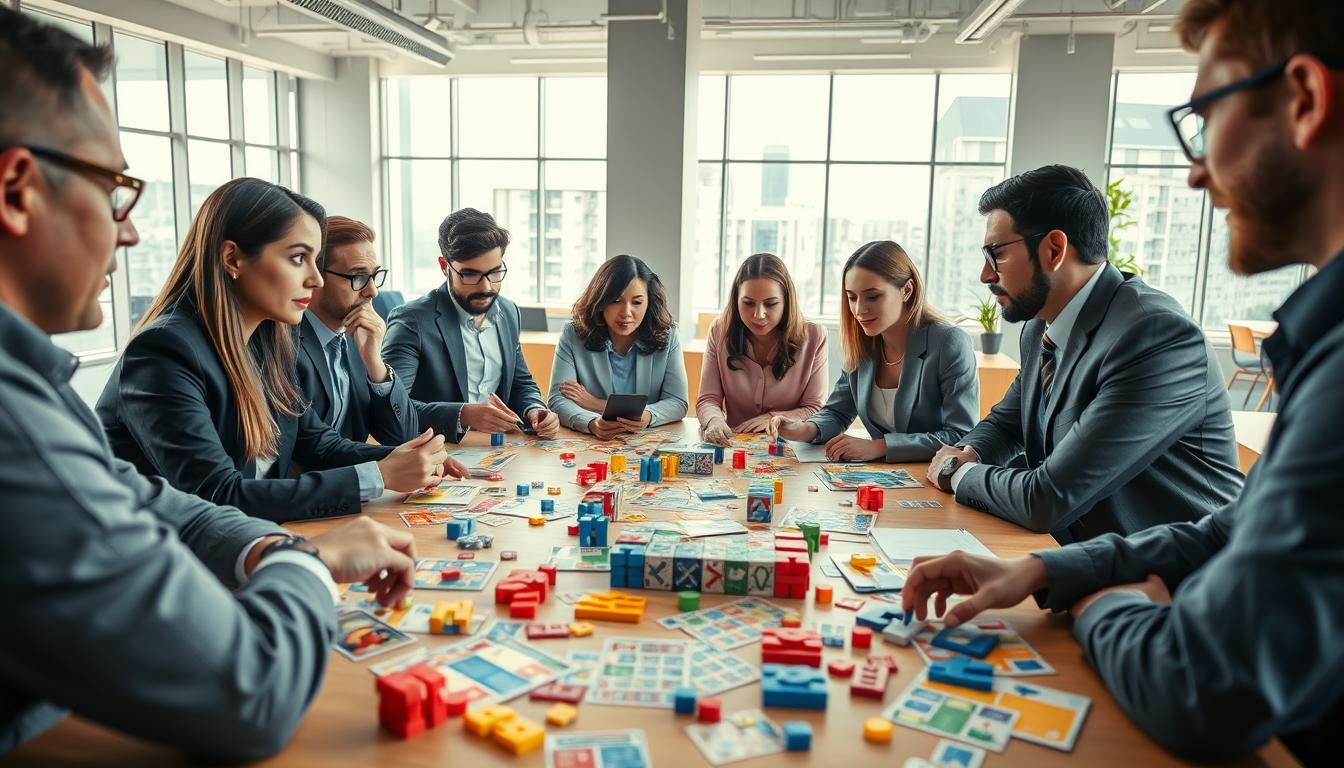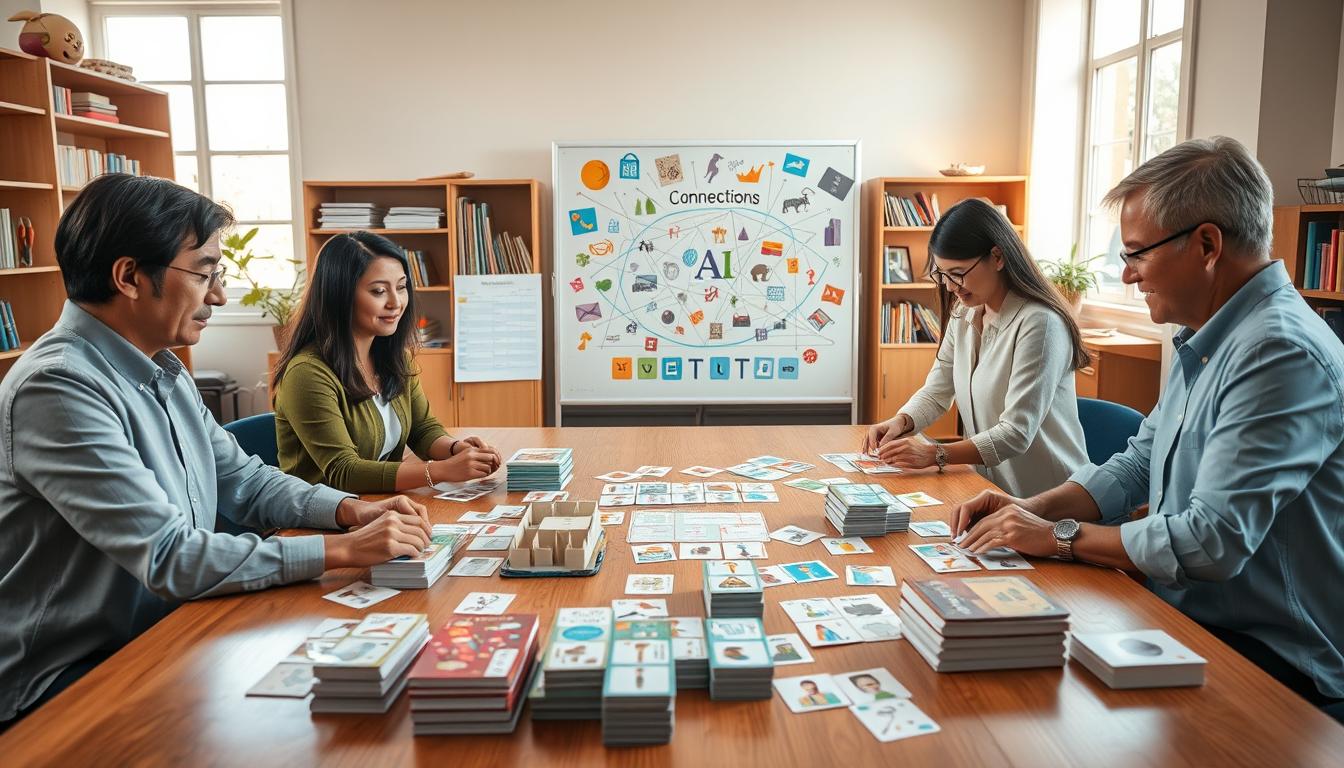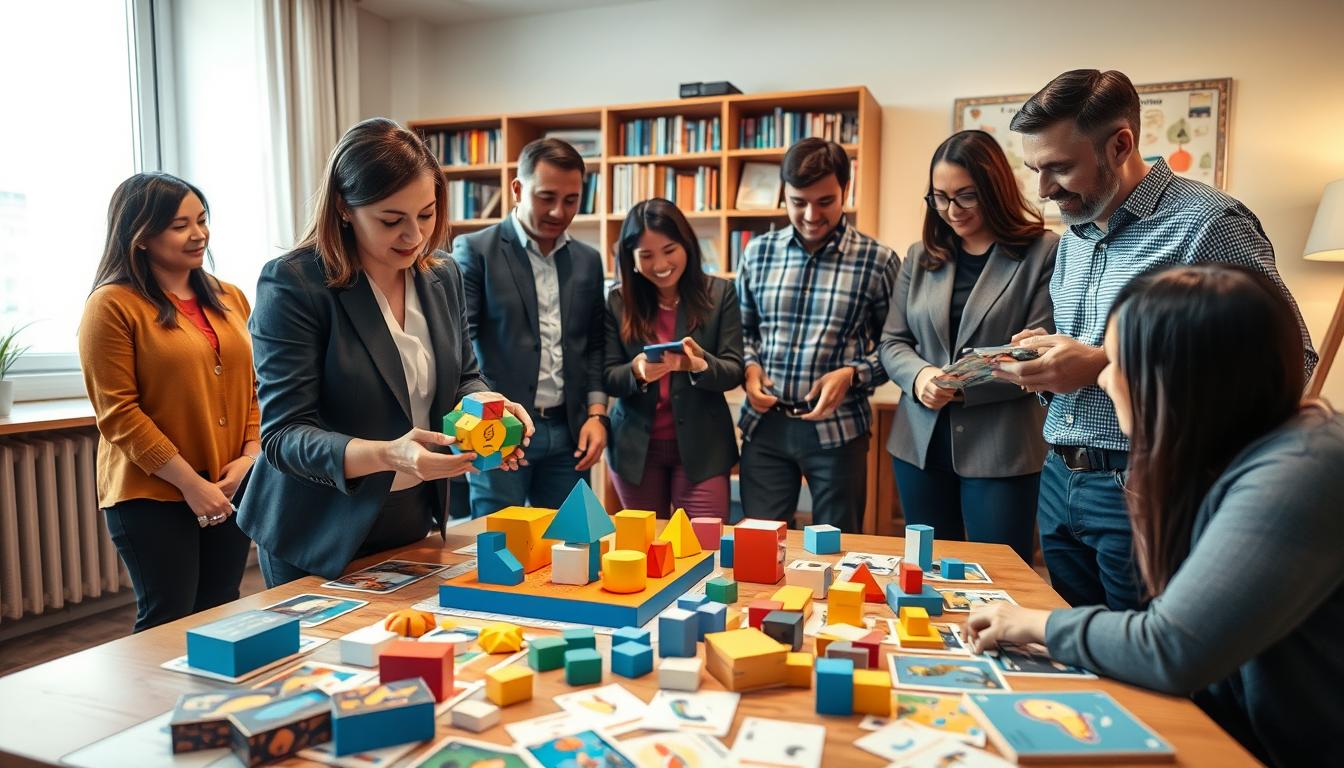Games that sharpen gesture and body language perception
Have you ever wondered how some people seem to get what others mean without saying a word? Understanding gestures and body language is key in both personal and professional life. In today’s world, it’s crucial to improve communication skills through fun ways.
This section will look at how brain games can help with non-verbal communication. We’ll see how body language games can make teams work better and increase productivity at work.
The Importance of Non-Verbal Communication
Non-verbal communication is key in building relationships and teamwork. It includes facial expressions, gestures, and posture. Understanding body language is crucial for bettering our social skills.
Studies show that knowing non-verbal cues can make teams work better. Teams with strong non-verbal skills have better teamwork and fewer mistakes. This makes the workplace better and helps everyone get along.
Companies that focus on non-verbal communication training do well. They create a culture of trust and openness. This leads to a more connected and productive team.

Understanding Body Language and Gestures
Body language is key in communication, showing feelings and plans through gestures and facial expressions. It helps us understand others better. Knowing how to read these signs can make our responses more fitting.
But, body language means different things in different cultures. What’s seen as friendly in one place might be seen as rude in another. Knowing these cultural differences helps us communicate better and avoid misunderstandings.
Learning to spot and understand non-verbal cues is important for both personal and work life. It helps us connect better and work together more effectively. By paying attention to body language, we can improve our communication skills.

Brain Games for Non-Verbal Communication Training
Non-verbal communication is key in sending and getting messages without words. Playing brain games that focus on this area can improve how we read emotions and connect with others. Knowing how to use non-verbal cues is vital for working well together and building strong relationships.
Types of Non-Verbal Communication
There are many types of non-verbal communication, each playing its own role in how we interact. These include:
- Proxemics: Using personal space to show how close or far we feel from others.
- Haptics: Touching as a way to communicate, which changes a lot based on culture and setting.
- Kinesics: Body language like gestures, posture, and facial expressions that show our feelings and attitudes.
Knowing these types helps us understand messages better and react in the right way.
Benefits of Non-Verbal Communication Skills
Improving non-verbal skills through brain games brings many advantages, such as:
- Enhanced teamwork, making work environments more united.
- Deeper relationships, as people get better at reading emotions and intentions.
- The skill to pick up on emotional signals, important for success in many areas.
These benefits lead to better communication, making us more effective in many situations.
Interactive Games for Enhancing Body Language Skills
Interactive games are great for improving body language skills. They help people understand non-verbal cues better. This leads to better communication among team members.
These games make learning fun. They also provide a real-world setting to practice reading gestures and facial expressions.
How Interactive Games Foster Understanding
Interactive games let players practice reading body language in action. They learn to spot subtle signals. This helps them understand emotions and intentions better.
Players get instant feedback. This helps them improve their non-verbal communication skills fast.
Team Dynamics and Body Language
Interactive games are key to better team dynamics. They help build trust and empathy. These are vital for good communication.
Playing together creates strong bonds. It makes the team more supportive. Better body language skills lead to more effective teamwork and stronger relationships.
| Game Name | Focus Area | Benefits |
|---|---|---|
| Charades | Gesture Interpretation | Improves ability to read body language |
| Team Pictionary | Visual Communication | Enhances collaboration and clarity in expression |
| Blindfolded Trust Walk | Non-Verbal Guidance | Boosts trust and mutual understanding |
Classic Games That Improve Gesture Recognition
Classic games are great for improving gesture recognition and developing non-verbal skills. Games like charades require players to show ideas without words. They learn to use body language and physical cues to communicate.
In Pictionary, players draw to show a word or phrase. This game teaches the importance of clear visuals in communication. It helps players understand how gestures can share complex thoughts.
These games promote teamwork and friendly competition. They help players improve their communication skills. As they play, they learn to read and use gestures to express feelings and plans.
Role-Playing Activities for Non-Verbal Cues
Role-playing activities let people dive into different characters and stories. They learn to spot and act on non-verbal signs in many situations. This way, they get better at talking and listening.
Scenario-Based Role Plays
Scenario-based learning shows how important setting is in talking. Each role play is set in a new place, showing how body language changes. People practice reading and reacting to small signs, helping them in real life.
Benefits of Role-Playing in Communication Training
Role-playing in training has many benefits. It helps people understand others better and see things from their point of view. It also teaches about how people interact, which is key for good relationships. By learning to read and respond to non-verbal signs, people can talk more effectively.
Non-Verbal Communication Games for Teams
Playing non-verbal communication games can really boost team-building. These games help team members understand body language and non-verbal signals. For example, in “Minefield,” players must navigate by following their teammates’ gestures and signals. This builds trust and teamwork.
In the “Mirror Game,” one person copies another’s movements. This game shows how to communicate without words. Players must watch each other’s body language closely. This improves their ability to send and receive non-verbal messages.
These games make teams better at expressing feelings and giving directions. They make working together easier. Adding these games to team activities can make the workplace more harmonious and productive.
Icebreaker Games That Cultivate Non-Verbal Skills
Icebreaker games are key in boosting non-verbal skills during team introductions. They are fun and interactive, helping people connect through body language and gestures. Games like “Human Bingo” or “Two Truths and a Lie” let team members show themselves without words.
Playing these games helps team members get better at reading each other’s non-verbal signals. This skill improves communication and teamwork at work. The games create a relaxed setting, helping people build trust and connections.
Adding icebreaker games to team-building events can really change how a group works together. These activities help build connections and understanding of non-verbal communication. This is crucial in today’s team-based work settings.
Creative Approaches in Body Language Training
New ways of teaching body language are changing the game. Instead of old methods, we’re using tech like virtual simulations and interactive software. This makes learning fun and lets people practice in a safe space.
Theater and storytelling are also key in body language training. They help people understand and use their body language better. Video analysis gives instant feedback, helping learners see and fix their body language on the spot.
These creative methods keep people interested and help them remember important skills. By using these new ways, companies can build teams that work well together. This leads to better teamwork and understanding.
Games That Foster Empathy Through Non-Verbal Communication
Empathy games are a special way to grow emotional intelligence. They use non-verbal communication to help people understand and share feelings. Players learn to read emotions through body language and facial expressions.
These games make us more aware of others’ feelings. They create a supportive space for everyone.
Building Emotional Intelligence with Games
Emotional intelligence is key in our personal and work lives. Games that focus on non-verbal communication help us understand emotions without words. Players learn to connect and empathize better through these games.
Empathy Development Activities
- Gesture Interpretation: Players take turns expressing various emotions through gestures, while others guess the emotions being conveyed.
- Facial Expression Charades: Participants act out emotions solely through facial expressions, fostering an understanding of how subtle cues communicate feelings.
- Empathy Role Plays: Scenarios are created where team members must respond to emotional cues from colleagues, promoting active listening and support.
These activities boost our skills in non-verbal communication. They help us build stronger relationships and a united team.
The Value of Observation in Non-Verbal Communication
Observation skills are key to good non-verbal communication. Paying attention to body language and facial expressions gives us deeper insights. These signs often tell us more than words can.
To get better at noticing these cues, look for changes in posture and gestures. For example, crossed arms might show someone is defensive. On the other hand, a real smile means they’re open and ready to talk. Spotting these signs helps us understand what’s really going on.
Having strong observation skills is important in both our personal and work lives. It helps us communicate better and build stronger relationships. It’s especially useful in teamwork, helping us work together more effectively.
How Non-Verbal Games Enhance Workplace Communication
Non-verbal games are a great way to boost workplace communication. They help employees get better at reading gestures, expressions, and body language. This makes it easier for everyone to understand each other better.
These games make the workplace more open and friendly. They help teams work together smoothly. Everyone learns to pay attention to non-verbal signals, which is key for teamwork.
Improving Team Collaboration and Trust
Good communication in the workplace is all about trust and teamwork. Non-verbal games let people show their feelings without words. This helps them understand each other better.
When employees play these games, they:
- Build trust: They learn to trust each other through shared experiences.
- Understand better: They get good at reading unspoken messages, cutting down on misunderstandings.
- Work better together: They practice teamwork, leading to better project results.
Adding non-verbal games to the workplace boosts important communication skills. This makes the team work more efficiently. It creates a better place to work.
Conclusion
Adding non-verbal games to communication training is key for team success. As more companies see the importance of good non-verbal skills, these games become vital. They help make teams work better together.
These games help teams get better at reading body language and gestures. They also make team members feel closer. This creates a place where everyone can work well together, be creative, and trust each other.
Using fun and new ways to teach non-verbal skills changes a workplace for the better. Companies that try these methods help their teams deal with tough social situations. This builds a strong team based on respect and understanding.
FAQ
What is the significance of non-verbal communication in the workplace?
Non-verbal cues like body language and gestures are key in work settings. They help build relationships and ensure clear communication. This leads to better teamwork and productivity.
How can games improve gesture recognition skills?
Games like charades and Pictionary make players express ideas without words. This practice sharpens their ability to read body language and facial expressions. It’s a fun way to improve gesture recognition skills.
What types of non-verbal communication are important to understand?
Understanding personal space (proxemics), touch (haptics), and body movement (kinesics) is crucial. These elements help convey messages effectively and improve interactions.
What are the benefits of using interactive games for body language training?
Interactive games boost teamwork, enhance understanding of non-verbal cues, and build trust. They help employees develop better communication skills and improve work dynamics.
How do role-playing exercises contribute to non-verbal communication skills?
Role-playing lets people practice recognizing and responding to body language cues. It shows how body language changes in different situations. This leads to better empathy and understanding.
What role do icebreaker games play in developing non-verbal communication skills?
Icebreaker games help people connect through non-verbal gestures in a relaxed setting. Games like “Human Bingo” build team connections and promote open communication.
How can technology be integrated into body language training?
Using video analysis and creative storytelling in training enhances body language skills. It makes learning more engaging and helps retain important skills.
Why is observation important in non-verbal communication?
Being able to observe body language and emotional cues is crucial. It leads to better communication and deeper relationships in both personal and professional life.
How can games lead to improved workplace dynamics?
Games that focus on non-verbal communication build trust and open communication. This creates a comfortable environment where everyone can express themselves. It reduces misunderstandings, boosts productivity, and strengthens the workplace culture.














